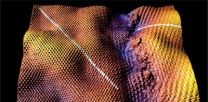(Press-News.org) Halfway between bacteria and tree
How the protein transport machinery in the chloroplasts of higher plants developed
Moss Physcomitrella patens is an evolutionary intermediate stage
Together with colleagues from Sweden, RUB researchers have studied how the protein transport system of bacteria developed over time to form the system in the chloroplasts of higher plants. They explored the so-called signal recognition particles (SRP) and their receptors. Bioinformatic and biochemical analyses revealed that the moss Physcomitrella patens has evolutionarily old and new components of the SRP system, and thus represents an intermediate stage in the development from the bacterial transport system to the chloroplast system in higher plants. The international team led by Prof. Dr. Danja Schünemann and Dr. Chantal Träger from the Working Group Molecular Biology of Plant Organelles at the Ruhr-Universität reported in the journal The Plant Cell.
The SRP system guides new proteins to their place of work
In the cell fluid, a special transport machinery conveys proteins from their origin to their place of work, for example in the cell membrane. The decisive factor is the so-called SRP system. It binds itself to the protein to be transported, travels with it to the cell membrane and interacts there with the SRP receptor (FtsY). If the SRP system binds to the receptor, cleavage of the energy storage molecule GTP triggers further processes which ultimately anchor the protein in the membrane.
From cyanobacterium to chloroplast
In the cell fluid of bacteria, animals and plants, the SRP system consists of two components: the protein SRP54 and the ribonucleic acid SRP RNA. Several years ago, researchers found that the chloroplasts of higher plants, i.e. the photosynthetically active cell components, possess their own SRP system. It is very different from the system of the cell fluid because it has no SRP RNA. However, alongside SRP54 it also contains the protein SRP43, which occurs exclusively in chloroplasts. Scientists assume that chloroplasts originated from cyanobacteria, which initially lived in symbiosis with plant progenitor cells and were ultimately integrated into the plant cells. The scientists have now explored how the RNA-free SRP system of the chloroplasts originated from the RNA-containing SRP system of the bacteria.
Plant kingdom bioinformatically examined
With the aid of bioinformatics, the Bochum biologists and Dr. Magnus Rosenblad of Gothenburg University first examined which representatives in the plant kingdom have which components of the SRP system in their chloroplasts. "We were surprised that many organisms from unicellular green algae to mosses and ferns possess the gene for the SRP RNA in their chloroplasts", says Danja Schünemann. "The only exceptions are the higher plants, which have lost this gene". For them, the SRP system consists solely of the proteins SRP54 and SRP43. Interestingly though, SRP43 also occurs in the chloroplasts of lower plants, which are still equipped with SRP RNA.
SRP RNA in moss has partially lost its function
In collaboration with several groups of the Collaborative Research Centre SFB 642 at the RUB, Dr. Chantal Träger investigated the biochemistry of the moss Physcomitrella patens, which is among the lower plants. Physcomitrella has all the conceivable components of the SRP system in its chloroplasts: both the evolutionarily old components SRP54 and SRP RNA, as well as the more recent evolutionary protein SRP43. However, the SRP RNA of the moss chloroplasts forms a longer loop than the bacterial SRP RNA. This altered structure apparently prevents it from regulating the cleavage of GTP. Physcomitrella patens thus contains the evolutionarily old SRP RNA, which has largely lost certain functions. The SRP system of the chloroplasts of Physcomitrella patens therefore represents the transition between bacteria and higher plants. An X-ray structure analysis also revealed that the SRP receptor (FtsY) of the moss already has properties of the protein of higher plants.
###Figures online
Two figures related to this press release can be found online at: http://aktuell.ruhr-uni-bochum.de/pm2013/pm00008.html.en
Further information
Prof. Dr. Danja Schünemann, Working Group Molecular Biology of Plant Organelles, Ruhr-Universität, 44780 Bochum, Germany, Tel. +49/234/32-24293, E-Mail: danja.schuenemann@rub.de
Dr. Chantal Träger, Working Group Molecular Biology of Plant Organelles, Ruhr-Universität, 44780 Bochum, Germany, Tel. +49234/32-29341, E-Mail: chantal.traeger@rub.de
Bibliographic record
C. Träger, M.A. Rosenblad, D. Ziehe, C. Garcia-Petit, L. Schrader, K. Kock, C.V. Richter, B. Klinkert , F. Narberhaus, C. Herrmann, E. Hofmann, H. Aronsson, D. Schünemann (2012): Evolution from the prokaryotic to the higher plant chloroplast Signal Recognition Particle: the Signal Recognition Particle RNA is conserved in plastids of a wide range of photosynthetic organisms, The Plant Cell, DOI: 10.1105/tpc.112.102996
Editor: Dr. Julia Weiler
How the protein transport machinery in the chloroplasts of higher plants developed
Moss Physcomitrella patens is an evolutionary intermediate stage
2013-01-15
ELSE PRESS RELEASES FROM THIS DATE:
Designer bacteria may lead to better vaccines
2013-01-15
AUSTIN, Texas — Researchers at The University of Texas at Austin have developed a menu of 61 new strains of genetically engineered bacteria that may improve the efficacy of vaccines for diseases such as flu, pertussis, cholera and HPV.
The strains of E. coli, which were described in a paper published this month in the journal PNAS, are part of a new class of biological "adjuvants" that is poised to transform vaccine design. Adjuvants are substances added to vaccines to boost the human immune response.
"For 70 years the only adjuvants being used were aluminum salts," ...
Chemistry resolves toxic concerns about carbon nanotubes
2013-01-15
Safety fears about carbon nanotubes, due to their structural similarity to asbestos, have been alleviated following research showing that reducing their length removes their toxic properties.
In a new study, published today in the journal Angewandte Chemie, evidence is provided that the asbestos-like reactivity and pathogenicity reported for long, pristine nanotubes can be completely alleviated if their surface is modified and their effective length is reduced as a result of chemical treatment.
First atomically described in the 1990s, carbon nanotubes are sheets of ...
Born to lead? Leadership can be an inherited trait, study finds
2013-01-15
Genetic differences are significantly associated with the likelihood that people take on managerial responsibilities, according to new research from UCL (University College London).
The study, published online in Leadership Quarterly, is the first to identify a specific DNA sequence associated with the tendency for individuals to occupy a leadership position. Using a large twin sample, the international research team, which included academics from Harvard, NYU, and the University of California, estimate that a quarter of the observed variation in leadership behaviour ...
Neon lights up exploding stars
2013-01-15
An international team of nuclear astrophysicists has shed new light on the explosive stellar events known as novae.
These dramatic explosions are driven by nuclear processes and make previously unseen stars visible for a short time. The team of scientists measured the nuclear structure of the radioactive neon produced through this process in unprecedented detail.
Their findings, reported in the US journal Physical Review Letters, show there is much less uncertainty in how quickly one of the key nuclear reactions will occur as well as in the final abundance of radioactive ...
New research gives insight into graphene grain boundaries
2013-01-15
Using graphene – either as an alternative to, or most likely as a complementary material with – silicon, offers the promise of much faster future electronics, along with several other advantages over the commonly used semiconductor. However, creating the one-atom thick sheets of carbon known as graphene in a way that could be easily integrated into mass production methods has proven difficult.
When graphene is grown, lattices of the carbon grains are formed randomly, linked together at different angles of orientation in a hexagonal network. However, when those orientations ...
Facebook posts not easily forgotten
2013-01-15
Facebook posts resonate significantly more with human nature than books or even human faces, according to a new study by Laura Mickes and colleagues from the University of California San Diego in the US. The difference in memory between these microblogs and actual published words from a page is as striking as the difference in memory between amnesiacs and healthy controls. The work is published online in Springer's journal Memory & Cognition.
Online social networking is very popular, and allows people to post their thoughts as microblogs, an opportunity that people exploit ...
The muscle response of footballers depends on their position on the field
2013-01-15
Football players display different muscle response parameters depending on the position that they hold on the pitch, according to a study conducted by a team of Spanish researchers which has been published in the 'Journal of electromyography and kinesiology'.
Scientists from the University of Vigo have analysed different muscle response parameters in 78 Spanish first division footballers who have been playing for between four and fifteen years. They found variations depending on the field position of the players.
Published in the 'Journal of Electromyography and Kinesiology', ...
Black carbon larger cause of climate change than previously assessed
2013-01-15
Black carbon is the second largest man-made contributor to global warming and its influence on climate has been greatly underestimated, according to the first quantitative and comprehensive analysis of this issue.
The landmark study published in the Journal of Geophysical Research-Atmospheres today says the direct influence of black carbon, or soot, on warming the climate could be about twice previous estimates. Accounting for all of the ways it can affect climate, black carbon is believed to have a warming effect of about 1.1 Watts per square meter (W/m2), approximately ...
No panaceas for Mexico's violent drug war, but prohibition has failed
2013-01-15
While Mexico and the United States have ramped up their efforts to control and perhaps defeat Mexico's increasingly violent drug cartels, the outcome of these efforts remains in doubt and no panaceas are in sight, but prohibition has once again proved to be a failure, according to a paper from Rice University's Baker Institute for Public Policy.
The paper by Rice sociologist William Martin, "Cartels, Corruption and Carnage in the Calderón Era," traces the origins and growth of Mexican drug cartels and the corruption, failed government policies and gruesome violence ...
In search of the big questions: Conserving the European Alps
2013-01-15
The European Alps range span eight countries from France to Slovenia and harbour an extraordinary diversity of habitats, plants and animals, including many species found nowhere else. They are widely considered to be one of the most important regions for the preservation of biodiversity in Europe. But the Alps are not just a natural paradise: they are the home and workplace of up to 14 million people and the destination for more than 100 million tourists each year. The resulting changes to the landscape have led to an increasing fragmentation of the plant and animal ...
LAST 30 PRESS RELEASES:
What causes some people’s gut microbes to produce high alcohol levels?
Global study reveals widespread burning of plastic for heating and cooking
MIT study shows pills that communicate from the stomach could improve medication adherence
Searching for the centromere: diversity in pathways key for cell division
Behind nature’s blueprints
Researchers search for why some people’s gut microbes produce high alcohol levels
Researchers find promising new way to boost the immune response to cancer
Coffee as a staining agent substitute in electron microscopy
Revealing the diversity of olfactory receptors in hagfish and its implications for early vertebrate evolution
Development of an ultrasonic sensor capable of cuffless, non-invasive blood pressure measurement
Longer treatment with medications for opioid use disorder is associated with greater probability of survival
Strategy over morality can help conservation campaigns reduce ivory demand, research shows
Rising temperatures reshape microbial carbon cycling during animal carcass decomposition in water
Achieving ultra-low-power explosive jumps via locust bio-hybrid muscle actuators
Plant-derived phenolic acids revive the power of tetracycline against drug-resistant bacteria
Cooperation: A costly affair in bacterial social behaviour?
Viruses in wastewater: Silent drivers of pollution removal and antibiotic resistance
Sub-iethal water disinfection may accelerate the spread of antibiotic resistance
Three in four new Australian moms struggle with body image
Post-stroke injection protects the brain in preclinical study
Cardiovascular risk score predicts multiple eye diseases
Health: estimated one in ten British adults used or interested in GLP-1 medications for weight loss
Exercise to treat depression yields similar results to therapy
Whooping cough vaccination for pregnant women strengthens babies’ immune system
Dramatic decline in new cases of orphanhood in Uganda driven by HIV treatment and prevention programs
Stopping weight loss drugs linked to weight regain and reversal of heart health markers
Higher intake of food preservatives linked to increased cancer risk
Mass General Brigham–developed cholera vaccine completes phase 1 trial
First experimental validation of a “150-year-old chemical common sense” direct visualization of the molecular structural changes in the ultrafast anthracene [4+4] photocycloaddition reaction
Lack of support for people on weight loss drugs leaves them vulnerable to nutritional deficiencies, say experts
[Press-News.org] How the protein transport machinery in the chloroplasts of higher plants developedMoss Physcomitrella patens is an evolutionary intermediate stage



